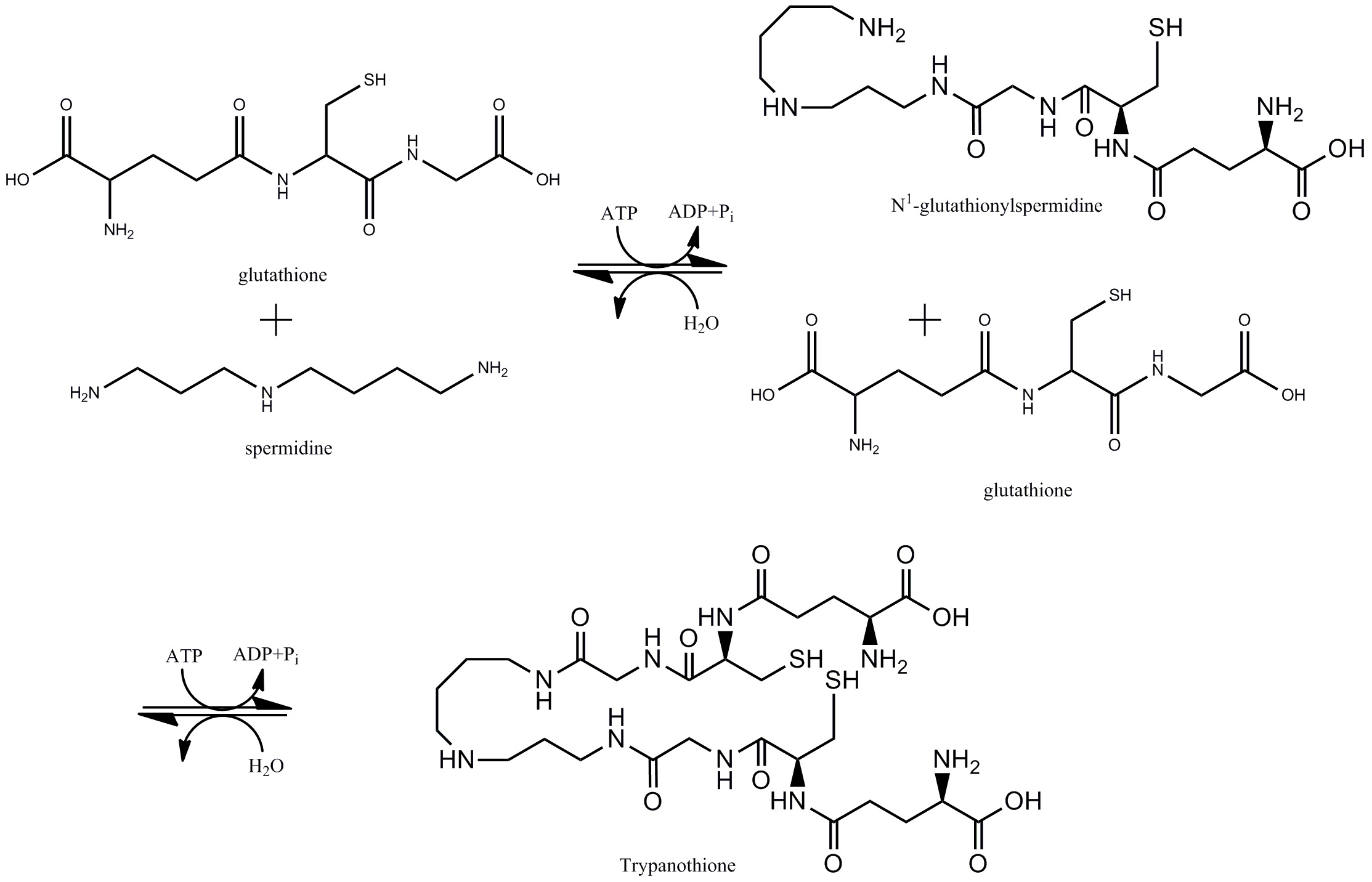|
Trypanothione Synthase
In enzymology, a trypanothione synthase () is an enzyme that catalyzes the chemical reaction :glutathione + glutathionylspermidine + ATP \rightleftharpoons N1,N8-bis(glutathionyl)spermidine + ADP + phosphate The 3 substrates of this enzyme are glutathione, glutathionylspermidine, and ATP, whereas its 3 products are N1,N8-bis(glutathionyl)spermidine, ADP, and phosphate. This reaction is especially important for protozoa in the order kinetoplastida as the molecule of N1,N8-bis(glutathionyl)spermidine, also known as trypanothione, is homologous to the function of glutathione in most other prokaryotic and eukaryotic cells. This means that it is a key intermediate in maintaining thiol redox within the cell and defending against harmful oxidative effects in such protozoa. This enzyme belongs to the family of ligases, specifically those forming carbon-nitrogen bonds as acid-D-ammonia (or amine) ligases (amide synthases). The systematic name of this enzyme class is glutathionylsp ... [...More Info...] [...Related Items...] OR: [Wikipedia] [Google] [Baidu] |
Enzymology
An enzyme () is a protein that acts as a biological catalyst by accelerating chemical reactions. The molecules upon which enzymes may act are called substrate (chemistry), substrates, and the enzyme converts the substrates into different molecules known as product (chemistry), products. Almost all metabolism, metabolic processes in the cell (biology), cell need enzyme catalysis in order to occur at rates fast enough to sustain life. Metabolic pathways depend upon enzymes to catalyze individual steps. The study of enzymes is called ''enzymology'' and the field of pseudoenzyme, pseudoenzyme analysis recognizes that during evolution, some enzymes have lost the ability to carry out biological catalysis, which is often reflected in their amino acid sequences and unusual 'pseudocatalytic' properties. Enzymes are known to catalyze more than 5,000 biochemical reaction types. Other biocatalysts include Ribozyme, catalytic RNA molecules, also called ribozymes. They are sometimes descr ... [...More Info...] [...Related Items...] OR: [Wikipedia] [Google] [Baidu] |
List Of Enzymes
Enzymes are listed here by their classification in the International Union of Biochemistry and Molecular Biology's Enzyme Commission (EC) numbering system: :Oxidoreductases (EC 1) ( Oxidoreductase) * Dehydrogenase * Luciferase * DMSO reductase :EC 1.1 (act on the CH-OH group of donors) * :EC 1.1.1 (with NAD+ or NADP+ as acceptor) ** Alcohol dehydrogenase (NAD) ** Alcohol dehydrogenase (NADP) ** Homoserine dehydrogenase ** Aminopropanol oxidoreductase ** Diacetyl reductase ** Glycerol dehydrogenase ** Propanediol-phosphate dehydrogenase ** glycerol-3-phoshitiendopene dehydrogenase (NAD+) ** D-xylulose reductase ** L-xylulose reductase ** Lactate dehydrogenase ** Malate dehydrogenase ** Isocitrate dehydrogenase ** HMG-CoA reductase * :EC 1.1.2 (with a cytochrome as acceptor) * :EC 1.1.3 (with oxygen as acceptor) ** Glucose oxidase ** L-gulonolactone oxidase ** Thiamine oxidase ** Xanthine oxidase * EC 1.1.4 (with a disulfide as accep ... [...More Info...] [...Related Items...] OR: [Wikipedia] [Google] [Baidu] |
Chagas Disease
Chagas disease, also known as American trypanosomiasis, is a tropical parasitic disease caused by ''Trypanosoma cruzi''. It is spread mostly by insects in the subfamily Triatominae, known as "kissing bugs". The symptoms change throughout the infection. In the early stage, symptoms are typically either not present or mild and may include fever, swollen lymph nodes, headaches, or swelling at the site of the bite. After four to eight weeks, untreated individuals enter the chronic phase of disease, which in most cases does not result in further symptoms. Up to 45% of people with chronic infections develop heart disease 10–30 years after the initial illness, which can lead to heart failure. Digestive complications, including an enlarged esophagus or an enlarged colon, may also occur in up to 21% of people, and up to 10% of people may experience nerve damage. is commonly spread to humans and other mammals by the kissing bug's bite wound and the bug's infected feces. The disea ... [...More Info...] [...Related Items...] OR: [Wikipedia] [Google] [Baidu] |
Nagana
Animal trypanosomiasis, also known as nagana and nagana pest, or sleeping sickness, is a disease of non-human vertebrates. The disease is caused by trypanosomes of several species in the genus ''Trypanosoma'' such as '' T. brucei'' (which also infects humans to cause African Sleeping Sickness), and '' T. vivax'' which causes nagana in livestock mainly in West Africa, although it has also spread to South America. The trypanosomes infect the blood of the vertebrate host, causing fever, weakness, and lethargy, which lead to weight loss and anemia. In some animals, the disease is fatal if not treated. The trypanosomes are transmitted by tsetse flies. An interesting feature is the remarkable tolerance to nagana pathology shown by some breeds of cattle, notably the N'Dama – a West African ''Bos taurus'' breed. This contrasts with the susceptibility shown by East African '' B. indicus'' cattle such as the zebu. Transmission Most trypanosomes develop in tsetse flies ('' Glossina'' ... [...More Info...] [...Related Items...] OR: [Wikipedia] [Google] [Baidu] |
Human African Trypanosomiasis
African trypanosomiasis is an insect-borne parasitic infection of humans and other animals. Human African trypanosomiasis (HAT), also known as African sleeping sickness or simply sleeping sickness, is caused by the species ''Trypanosoma brucei''. Humans are infected by two types, ''Trypanosoma brucei gambiense'' (TbG) and ''Trypanosoma brucei rhodesiense'' (TbR). TbG causes over 92% of reported cases. Both are usually transmitted by the bite of an infected tsetse fly and are most common in rural areas. Initially, the first stage of the disease is characterized by fevers, headaches, itchiness, and joint pains, beginning one to three weeks after the bite. Weeks to months later, the second stage begins with confusion, poor coordination, numbness, and trouble sleeping. Diagnosis involves detecting the parasite in a blood smear or lymph node fluid. A lumbar puncture is often needed to tell the difference between first- and second-stage disease. Prevention of severe disease i ... [...More Info...] [...Related Items...] OR: [Wikipedia] [Google] [Baidu] |



